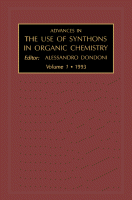Browse content
Table of contents
Actions for selected chapters
- Full text access
- Book chapterNo access
NEW FORMYL ANION AND CATION EQUIVALENTS
Alessandro Dondoni and Lino Colombo
Pages 1-49 - Book chapterNo access
TRIMETHYLSILYLDIAZOMETHANE: A VERSATILE SYNTHON FOR ORGANIC SYNTHESIS
Takayuki Shioiri and Toyohiko Aoyama
Pages 51-101 - Book chapterNo access
FROM PUSH–PULL-SUBSTITUTED ALLENES TO TETRANUCLEAR CHELATE COMPLEXES VIA SPONTANEOUS SELF-ASSEMBLY: THE SYNTHON STRATEGY AS A GUIDE
Rolf W. Saalfrank and Roman Burak
Pages 103-141 - Book chapterNo access
CHIRAL SYNTHONS VIA ENZYME-MEDIATED ASYMMETRIZATION OF MESO-COMPOUNDS
Bruno Danieli, Giordano Lesma, ... Sergio Riva
Pages 143-219 - Book chapterNo access
INDEX
Pages 221-227
About the book
Description
Advances in the Use of Synthons in Organic Chemistry: A Research Annual, Volume 1 provides information pertinent to a useful reagent that can perform a certain chemical operation that is otherwise impossible or difficult to carry out. This book presents the developments on established synthons. Organized into four chapters, this volume begins with an overview of the significant role of the formyl group in synthetic methodologies, which has stimulated the search for other reagents. This text then describes trimethysilyldiazomethane as a stable and safe substitute for hazardous diazomethane. Other chapters consider the usefulness of trimethysilyldiazomethane in organic syntheses. This book discusses as well that malonic amides, silylenol ethers, malonic esters, and tetra-donor-substituted allenes serve as synthetic equivalents for the dianions of malonic esters, ketones, and malonic amides. The final chapter deals with the synthesis of biologically-active compounds, which has been one of the major challenges for organic chemists. This book is a valuable resource for practicing synthetic chemists.
Advances in the Use of Synthons in Organic Chemistry: A Research Annual, Volume 1 provides information pertinent to a useful reagent that can perform a certain chemical operation that is otherwise impossible or difficult to carry out. This book presents the developments on established synthons. Organized into four chapters, this volume begins with an overview of the significant role of the formyl group in synthetic methodologies, which has stimulated the search for other reagents. This text then describes trimethysilyldiazomethane as a stable and safe substitute for hazardous diazomethane. Other chapters consider the usefulness of trimethysilyldiazomethane in organic syntheses. This book discusses as well that malonic amides, silylenol ethers, malonic esters, and tetra-donor-substituted allenes serve as synthetic equivalents for the dianions of malonic esters, ketones, and malonic amides. The final chapter deals with the synthesis of biologically-active compounds, which has been one of the major challenges for organic chemists. This book is a valuable resource for practicing synthetic chemists.
Details
ISBN
978-1-4831-0094-4
Language
English
Published
1993
Copyright
Copyright © 1993 Elsevier Ltd. All rights reserved.
Imprint
JAI Press
